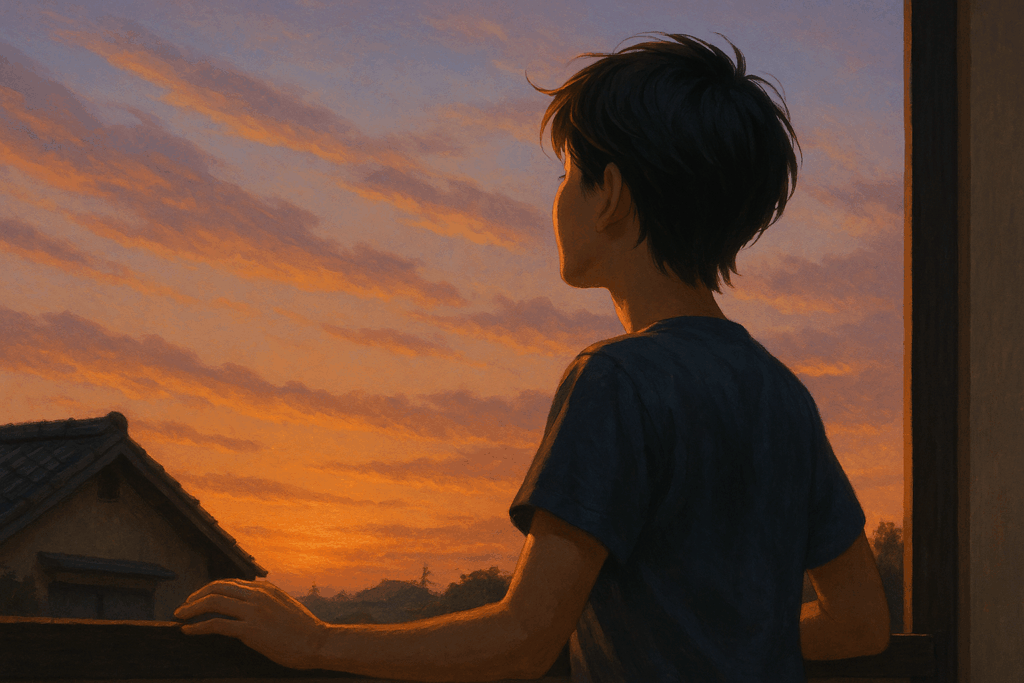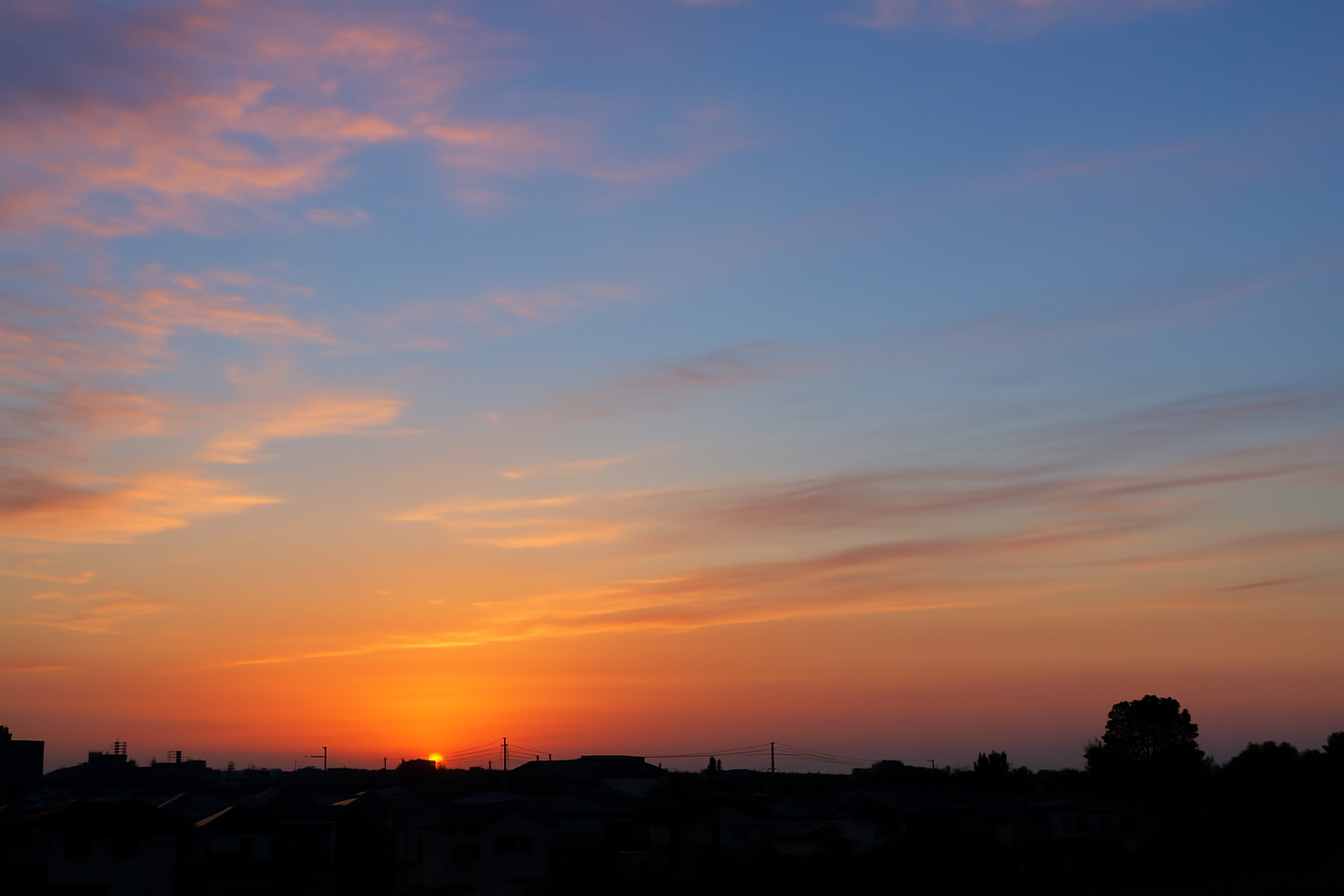つい先日、「虫の声に気づく夜」を綴った。耳を澄ませば、夏の終わりを静かに告げる小さな声に気づく。そんな聴覚的な秋の気配を感じたばかりだが、今度は目から季節を実感している自分がいる。

九月に入っても昼間の暑さは厳しいままだ。アスファルトの上を歩けば容赦なく熱がこもり、気温はまだ真夏を思わせる。けれど、日の入りだけは確実に早くなってきた。関東では、午後六時を迎える頃にはもうあたりが暗くなり始める。九州など西の地域に比べると三十分から一時間も早く夜が訪れるというのだから、この差は大きい。
気温は夏そのものでも、視覚的には秋の気配が漂ってくる。夕暮れの早さに、どこか心細さや寂しさを覚える。長く照りつけていたあの灼熱の太陽が、少しずつ力を弱めているのだ。日差しが短くなることで、ようやく「季節が変わっていくのだ」と心が納得しはじめる。
秋になると、食材もまた豊かに姿を現す。松茸、栗、柿、秋刀魚、鰹…。店先に並ぶ色とりどりの旬の味覚は、視覚的にも味覚的にも秋の訪れを知らせてくれる。自然の恵みとともに季節を感じるのは、日本人にとってごく当たり前の習慣だろう。
ただ、近年は春や秋が短くなり、あっという間に通り過ぎてしまうようにも思う。夏と冬が長く主役を張り、その間の移ろいの季節は、気づけばほんのわずかしか残っていない。だからこそ、私たちは意識して小さな変化を感じ取り、季節を堪能する必要があるのかもしれない。
耳で感じる虫の声、目で捉える早い夕暮れ。ひとつひとつの感覚を研ぎ澄ませば、確かに季節はそこにある。気温に惑わされて「まだ夏だ」と思っていても、暦も自然も、少しずつ秋へと歩みを進めている。
短い秋だからこそ、ほんの一瞬の色や音に心を寄せる。そうして過ごす時間は、忙しさに流されがちな日常に、ささやかな深呼吸を与えてくれる。暮れる空に夏の名残を探しながら、その向こうにある秋を迎え入れる準備を、心の中で少しずつ始めている。
夕暮れ空の変化を見ていると、ふと子どもの頃を思い出す。夏休みの終わり、宿題を抱えたまま茜色の空を見上げ、「もっと遊びたかった」と胸が締めつけられた。あの感覚は、夕暮れの早さとともに季節が動いていることを初めて意識させる体験だったのかもしれない。
今もなお、夕焼けに染まる街並みを眺めると、心の奥に同じ切なさがよみがえる。けれど、大人になった今はその切なさを否定するのではなく、むしろ大切に抱きしめたいと思う。寂しさの中には、確かに「季節を感じ取る力」が宿っているからだ。
また、夕暮れは人々の生活リズムにも影響を与える。暗くなるのが早まると、家路を急ぐ人の足取りは自然と速くなる。街灯が灯る時刻が少しずつ前倒しになることで、街全体の雰囲気も夏から秋へと移り変わっていく。そうした日常の小さな変化を意識できることは、忙しさに流されがちな現代において貴重なことだと思う。
そして、秋は文化の季節でもある。夜が長くなることで読書や音楽に向き合う時間が増え、心を豊かにする機会が訪れる。虫の声を聞きながらページをめくる夜や、暮れゆく空を眺めながら旋律に耳を傾けるひとときは、秋ならではの贅沢だ。
夕暮れは、ただの「終わり」ではなく、新しい時間の入口でもある。夏の余韻を見つめつつ、次の季節を迎える準備をするその瞬間にこそ、人生の深みが宿るのだと感じる。
- [虫の声に気づく夜 — 夏の終わりに]
小さな虫の声から季節の歩みを感じるエッセイです。 - [雨上がりの空と、水の中の静けさ]
台風一過の朝や水の中で感じた秋の気配を綴った記事です。
Searching for Summer’s Traces in the Fading Sky
Just the other day, I wrote about “noticing the voices of insects at night.” By listening closely, I could sense the quiet signal of summer drawing to a close. That was how I felt autumn through sound, but now I find myself sensing the season through sight.

Even in September, the daytime heat remains relentless. Walking on the asphalt, the air still radiates midsummer’s intensity. Yet the sunset tells a different story. Here in the Kanto region, the sky darkens around six o’clock, nearly thirty minutes to an hour earlier than in Kyushu or the western parts of Japan. The difference is striking.
Though the temperature clings to summer, visually the signs of autumn are undeniable. The early arrival of night stirs a faint loneliness, a quiet sense that the blazing summer sun is slowly losing its strength. As the days grow shorter, I begin to feel that the season is, indeed, shifting.
Autumn also brings an abundance of seasonal foods: matsutake mushrooms, chestnuts, persimmons, Pacific saury, bonito. Markets fill with colors and flavors that announce the season, reminding us—through both sight and taste—that autumn is near. For the Japanese, to notice these changes in nature and savor the season has long been a familiar custom.
Yet in recent years, it seems spring and autumn have grown shorter, slipping past almost before we realize it. Summer and winter dominate, leaving little time for the subtle transitions in between. That makes it all the more important to pay attention to the small signs—whether in sound or sight—that reveal the season’s quiet presence.
The voices of insects heard with the ear, the early dusk seen with the eye—each sense draws out autumn in its own way. Even if the heat insists that summer is still here, the calendar and nature continue their steady walk toward the next season.
Because autumn passes so quickly, we need to give ourselves over to those fleeting moments: the colors of the fading sky, the sounds carried by the night air. In doing so, we let our busy lives pause for a breath. As I search for summer’s traces in the fading sky, I find myself quietly preparing to welcome the autumn that lies ahead.
When I gaze at the changing sky at dusk, childhood memories suddenly return. At the end of summer vacation, with unfinished homework still on my desk, I would look up at the crimson sky and feel my chest tighten with the thought, “I wanted to play more.” Perhaps that bittersweet sensation was my very first awareness that the seasons were moving forward.
Even now, whenever I see the town dyed in sunset colors, the same sense of sorrow resurfaces deep inside. Yet as an adult, I no longer deny that sorrow; instead, I choose to embrace it. For within that sadness lies the very ability to feel the season.
Dusk also influences the rhythm of daily life. As night falls earlier, people naturally quicken their steps homeward. The streetlights turning on earlier each day subtly transform the atmosphere of the city, shifting it from summer into autumn. To notice such small changes is precious in today’s busy world, where time often slips away unnoticed.
And autumn is also the season of culture. With longer nights, there is more time for reading and music, moments that enrich the heart. Evenings spent turning pages while listening to insects, or gazing at the twilight sky while soaking in a melody — such moments are luxuries unique to autumn.
Dusk is not merely an “ending,” but also the entrance to a new time. In the act of gazing at the lingering traces of summer while preparing to welcome the next season, I feel the depth of life itself.
🔗Related Articles
- [Noticing the Insects’ Chorus — At Summer’s End]
An essay on sensing the change of season through tiny insect voices. - [The Sky After the Rain, and the Silence Within the Water]
Reflections on autumn’s presence after a typhoon and in the stillness of water.




コメント